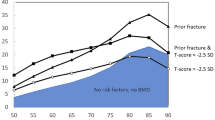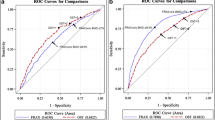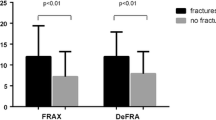Abstract
Osteoporotic fractures are common in postmenopausal women. Tools are available to estimate the risk of low bone mineral density (BMD) or fracture. This systematic review retrieved articles that evaluated osteoporosis risk assessment tools among postmenopausal women in North America. For identifying BMD T-score ≤−2.5, most studies of the Simple Calculated Osteoporosis Risk Estimation tool (SCORE) and Osteoporosis Risk Assessment Instrument (ORAI) reported sensitivity ≥90 %. Area under the receiver operating characteristic curve (AUC) was usually <0.75 for SCORE and ≥0.75 for ORAI. Among women 50–64 years old, a Fracture Risk Assessment Tool (FRAX) threshold ≥9.3 % had a sensitivity of 33 % for identifying BMD T-score ≤−2.5 and 26 % for predicting major osteoporotic fracture (MOF). For predicting MOF, sensitivity was higher for SCORE and Osteoporosis Self-assessment Tool equation (OST), and higher in women ≥65 years old. For predicting BMD T-score ≤−2.5 in women ≥65 years old, the sensitivities of SCORE; ORAI; and Age, Body Size, No Estrogen (ABONE) were very high. No optimal osteoporosis risk assessment tool is available for identifying low BMD and MOF risk.

Similar content being viewed by others
References
Papers of particular interest, published recently, have been highlighted as: • Of importance •• Of major importance
U.S. Department of Health and Human Services. Bone health and osteoporosis: a report of the Surgeon General Executive Summary. Rockville, MD: 2004.
Consensus development conference: prophylaxis and treatment of osteoporosis. Am J Med. 1991;90(1):107–10.
Screening for osteoporosis: U.S. preventive services task force recommendation statement. Ann Intern Med. 2011;154(5):356–64.
Wright NC, Looker AC, Saag KG, Curtis JR, Delzell ES, Randall S, et al. The recent prevalence of osteoporosis and low bone mass in the United States based on bone mineral density at the femoral neck or lumbar spine. J Bone Miner Res. 2014.
National Osteoporosis Foundation. Clinician’s guide to prevention and treatment of osteoporosis. Washington, DC: National Osteoporosis Foundation, 2014.
Crandall CJ, Newberry SJ, Diamant A, Lim YW, Gellad WF, Booth MJ, et al. Comparative effectiveness of pharmacologic treatments to prevent fractures: an updated systematic review. Ann Intern Med. 2014;161(10):711–23.
Watts NB, Bilezikian JP, Camacho PM, Greenspan SL, Harris ST, Hodgson SF, et al. American Association of Clinical Endocrinologists Medical Guidelines for Clinical Practice for the diagnosis and treatment of postmenopausal osteoporosis. Endocr Pract. 2010;16 Suppl 3:1–37.
Cadarette SM, Jaglal SB, Murray TM, McIsaac WJ, Joseph L, Brown JP, et al. Evaluation of decision rules for referring women for bone densitometry by dual-energy x-ray absorptiometry. JAMA. 2001;286(1):57–63.
Cadarette SM, Jaglal SB, Kreiger N, McIsaac WJ, Darlington GA, Tu JV. Development and validation of the Osteoporosis Risk Assessment Instrument to facilitate selection of women for bone densitometry. CMAJ. 2000;162(9):1289–94.
Cadarette SM, McIsaac WJ, Hawker GA, Jaakkimainen L, Culbert A, Zarifa G, et al. The validity of decision rules for selecting women with primary osteoporosis for bone mineral density testing. Osteoporos Int. 2004;15(5):361–6.
Cadarette SM, Jaglal SB, Murray TM. Validation of the simple calculated osteoporosis risk estimation (SCORE) for patient selection for bone densitometry. Osteoporos Int. 1999;10(1):85–90.
Brenneman SK, Lacroix AZ, Buist DS, Chen YT, Abbott 3rd TA. Evaluation of decision rules to identify postmenopausal women for intervention related to osteoporosis. Dis Manag. 2003;6(3):159–68.
Black DM, Steinbuch M, Palermo L, Dargent-Molina P, Lindsay R, Hoseyni MS, et al. An assessment tool for predicting fracture risk in postmenopausal women. Osteoporos Int. 2001;12(7):519–28.
Bolland MJ, Siu AT, Mason BH, Horne AM, Ames RW, Grey AB, et al. Evaluation of the FRAX and Garvan fracture risk calculators in older women. J Bone Miner Res. 2011;26(2):420–7.
Brennan SL, Leslie WD, Lix LM, Johansson H, Oden A, McCloskey E, et al. FRAX provides robust fracture prediction regardless of socioeconomic status. Osteoporos Int. 2014;25(1):61–9.
Ettinger B, Hillier TA, Pressman A, Che M, Hanley DA. Simple computer model for calculating and reporting 5-year osteoporotic fracture risk in postmenopausal women. J Womens Health (Larchmt). 2005;14(2):159–71.
FitzGerald G, Compston JE, Chapurlat RD, Pfeilschifter J, Cooper C, Hosmer Jr DW, et al. Empirically based composite fracture prediction model from the Global Longitudinal Study of Osteoporosis in Postmenopausal Women (GLOW). J Clin Endocrinol Metab. 2014;99(3):817–26.
Gourlay ML, Miller WC, Richy F, Garrett JM, Hanson LC, Reginster JY. Performance of osteoporosis risk assessment tools in postmenopausal women aged 45–64 years. Osteoporos Int. 2005;16(8):921–7.
Hawker G, Mendel A, Lam MA, Akhavan PS, Cancino-Romero J, Waugh E, et al. A clinical decision rule to enhance targeted bone mineral density testing in healthy mid-life women. Osteoporos Int. 2012;23(7):1931–8.
Henry MJ, Pasco JA, Merriman EN, Zhang Y, Sanders KM, Kotowicz MA, et al. Fracture risk score and absolute risk of fracture. Radiology. 2011;259(2):495–501.
Jiang X, Westermann LB, Galleo GV, Demko J, Marakovits KA, Schnatz PF. Age as a predictor of osteoporotic fracture compared with current risk-prediction models. Obstet Gynecol. 2013;122(5):1040–6.
Langsetmo L, Morin S, Kovacs CS, Kreiger N, Josse R, Adachi JD, et al. Determining whether women with osteopenic bone mineral density have low, moderate, or high clinical fracture risk. Menopause. 2010;17(5):1010–6.
Leslie WD, Lix LM, Wu X, Manitoba Bone Density P. Competing mortality and fracture risk assessment. Osteoporos Int. 2013;24(2):681–8.
Leslie WD, Brennan SL, Lix LM, Johansson H, Oden A, McCloskey E, et al. Direct comparison of eight national FRAX(R) tools for fracture prediction and treatment qualification in Canadian women. Arch Osteoporos. 2013;8(1–2):145.
Leslie WD, Morin S, Lix LM, Johansson H, Oden A, McCloskey E, et al. Fracture risk assessment without bone density measurement in routine clinical practice. Osteoporos Int. 2012;23(1):75–85.
Leslie WD, Majumdar SR, Lix LM, Johansson H, Oden A, McCloskey E, et al. High fracture probability with FRAX usually indicates densitometric osteoporosis: implications for clinical practice. Osteoporos Int. 2012;23(1):391–7.
Leslie WD, Lix LM, Langsetmo L, Berger C, Goltzman D, Hanley DA, et al. Construction of a FRAX(R) model for the assessment of fracture probability in Canada and implications for treatment. Osteoporos Int. 2011;22(3):817–27.
Leslie WD, Lix LM, Johansson H, Oden A, McCloskey E, Kanis JA. Spine-hip discordance and fracture risk assessment: a physician-friendly FRAX enhancement. Osteoporos Int. 2011;22(3):839–47.
Leslie WD, Lix LM. Manitoba Bone Density P. Absolute fracture risk assessment using lumbar spine and femoral neck bone density measurements: derivation and validation of a hybrid system. J Bone Miner Res. 2011;26(3):460–7.
Leslie WD, Berger C, Langsetmo L, Lix LM, Adachi JD, Hanley DA, et al. Construction and validation of a simplified fracture risk assessment tool for Canadian women and men: results from the CaMos and Manitoba cohorts. Osteoporos Int. 2011;22(6):1873–83.
Leslie WD, Kovacs CS, Olszynski WP, Towheed T, Kaiser SM, Prior JC, et al. Spine-hip T-score difference predicts major osteoporotic fracture risk independent of FRAX((R)): a population-based report from CAMOS. J Clin Densitom. 2011;14(3):286–93.
Leslie WD, Morin S. Fracture burden in relation to low bone mineral density and FRAX((R)) probability. J Clin Densitom. 2011;14(3):279–85.
Leslie WD, Lix LM, Johansson H, Oden A, McCloskey E, Kanis JA, et al. Independent clinical validation of a Canadian FRAX tool: fracture prediction and model calibration. J Bone Miner Res. 2010;25(11):2350–8.
Leslie WD, Lix LM, Manitoba Bone Density P. Simplified 10-year absolute fracture risk assessment: a comparison of men and women. J Clin Densitom. 2010;13(2):141–6.
Leslie WD, Tsang JF, Lix LM, Manitoba Bone Density P. Simplified system for absolute fracture risk assessment: clinical validation in Canadian women. J Bone Miner Res. 2009;24(2):353–60.
Leslie WD, Metge C, Ward L. Contribution of clinical risk factors to bone density-based absolute fracture risk assessment in postmenopausal women. Osteoporos Int. 2003;14(4):334–8.
Lo JC, Pressman AR, Chandra M, Ettinger B. Fracture risk tool validation in an integrated healthcare delivery system. Am J Manag Care. 2011;17(3):188–94.
Melton 3rd LJ, Atkinson EJ, Khosla S, Oberg AL, Riggs BL. Evaluation of a prediction model for long-term fracture risk. J Bone Miner Res. 2005;20(4):551–6.
Pang WY, Inderjeeth CA. FRAX without bone mineral density versus osteoporosis self-assessment screening tool as predictors of osteoporosis in primary screening of individuals aged 70 and older. J Am Geriatr Soc. 2014;62(3):442–6.
Pluskiewicz W, Drozdzowska B, Adamczyk P. Ten-year fracture risk in the assessment of osteoporosis management efficacy in postmenopausal women: a pilot study. Climacteric. 2013;16(1):117–26.
Roux S, Cabana F, Carrier N, Beaulieu M, April PM, Beaulieu MC, et al. The World Health Organization Fracture Risk Assessment Tool (FRAX) underestimates incident and recurrent fractures in consecutive patients with fragility fractures. J Clin Endocrinol Metab. 2014;99(7):2400–8.
Wei GS, Jackson JL. Postmenopausal bone density referral decision rules: correlation with clinical fractures. Mil Med. 2004;169(12):1000–4.
Gourlay ML, Powers JM, Lui LY, Ensrud KE, Study of Osteoporotic Fractures Research G. Clinical performance of osteoporosis risk assessment tools in women aged 67 years and older. Osteoporos Int. 2008;19(8):1175–83.
Mauck KF, Cuddihy MT, Atkinson EJ, Melton 3rd LJ. Use of clinical prediction rules in detecting osteoporosis in a population-based sample of postmenopausal women. Arch Intern Med. 2005;165(5):530–6.
Ungar WJ, Josse R, Lee S, Ryan N, Adachi R, Hanley D, et al. The Canadian SCORE questionnaire: optimizing the use of technology for low bone density assessment. Simple calculated osteoporosis risk estimate. J Clin Densitom. 2000;3(3):269–80.
Von Muhlen D, Visby Lunde A, Barrett-Connor E, Bettencourt R. Evaluation of the simple calculated osteoporosis risk estimation (SCORE) in older Caucasian women: the Rancho Bernardo study. Osteoporos Int. 1999;10(1):79–84.
Wallace LS, Ballard JE, Holiday D, Turner LW, Keenum AJ, Pearman CM. Evaluation of decision rules for identifying low bone density in postmenopausal African-American women. J Natl Med Assoc. 2004;96(3):290–6.
Leslie WD, Lix LM, Johansson H, Oden A, McCloskey E, Kanis JA, et al. Selection of women aged 50–64 yr for bone density measurement. J Clin Densitom. 2013;16(4):570–8. These studies with large sample sizes evaluated FRAX in women aged 50–64 years.
Lydick E, Cook K, Turpin J, Melton M, Stine R, Byrnes C. Development and validation of a simple questionnaire to facilitate identification of women likely to have low bone density. Am J Manag Care. 1998;4(1):37–48.
lyCass AR, Shepherd AJ, Carlson CA. Osteoporosis risk assessment and ethnicity: validation and comparison of 2 clinical risk stratification instruments. J Gen Intern Med. 2006;21(6):630–5.
Crandall CJ, Larson J, Gourlay ML, Donaldson MG, LaCroix A, Cauley JA, et al. Osteoporosis screening in postmenopausal women 50 to 64 years old: comparison of US Preventive Services Task Force strategy and two traditional strategies in the Women’s Health Initiative. J Bone Miner Res. 2014;29(7):1661–6. These studies with large sample sizes evaluated FRAX in women aged 50–64 years.
Crandall CJ, Larson JC, Watts NB, Gourlay ML, Donaldson MG, LaCroix A, et al. Comparison of fracture risk prediction by the US Preventive Services Task Force strategy and two alternative strategies in women 50–64 years old in the Women’s Health Initiative. J Clin Endocrinol Metab. 2014;99(12):4514–22. These studies with large sample sizes evaluated FRAX in women aged 50–64 years.
Ensrud KE, Lui LY, Taylor BC, Schousboe JT, Donaldson MG, Fink HA, et al. A comparison of prediction models for fractures in older women: is more better? Arch Intern Med. 2009;169(22):2087–94.
Fraser LA, Langsetmo L, Berger C, Ioannidis G, Goltzman D, Adachi JD, et al. Fracture prediction and calibration of a Canadian FRAX(R) tool: a population-based report from CaMos. Osteoporos Int. 2011;22(3):829–37.
Girman CJ, Chandler JM, Zimmerman SI, Martin AR, Hawkes W, Hebel JR, et al. Prediction of fracture in nursing home residents. J Am Geriatr Soc. 2002;50(8):1341–7.
Leslie WD, Lix LM, Johansson H, Oden A, McCloskey E, Kanis JA, et al. A comparative study of using non-hip bone density inputs with FRAX(R). Osteoporos Int. 2012;23(3):853–60. These studies with large sample sizes evaluated FRAX in women aged 50–64 years.
Premaor M, Parker RA, Cummings S, Ensrud K, Cauley JA, Lui LY, et al. Predictive value of FRAX for fracture in obese older women. J Bone Miner Res. 2013;28(1):188–95.
Pressman AR, Lo JC, Chandra M, Ettinger B. Methods for assessing fracture risk prediction models: experience with FRAX in a large integrated health care delivery system. J Clin Densitom. 2011;14(4):407–15.
Langsetmo L, Nguyen TV, Nguyen ND, Kovacs CS, Prior JC, Center JR, et al. Independent external validation of nomograms for predicting risk of low-trauma fracture and hip fracture. CMAJ. 2011;183(2):E107–14.
Rubin KH, Friis-Holmberg T, Hermann AP, Abrahamsen B, Brixen K. Risk assessment tools to identify women with increased risk of osteoporotic fracture: complexity or simplicity? A systematic review. J Bone Miner Res. 2013;28(8):1701–17.
Rud B, Hilden J, Hyldstrup L, Hrobjartsson A. Performance of the Osteoporosis Self-Assessment Tool in ruling out low bone mineral density in postmenopausal women: a systematic review. Osteoporos Int. 2007;18(9):1177–87.
Compliance with Ethics Guidelines
Conflict of Interest Statement
The author of this paper declares no conflicts of interest.
Human and Animal Rights and Informed Consent
This article contains no studies with human or animal subjects performed by the author.
Author information
Authors and Affiliations
Corresponding author
Additional information
This article is part of the Topical Collection on Epidemiology and Pathophysiology
Rights and permissions
About this article
Cite this article
Crandall, C.J. Risk Assessment Tools for Osteoporosis Screening in Postmenopausal Women: A Systematic Review. Curr Osteoporos Rep 13, 287–301 (2015). https://doi.org/10.1007/s11914-015-0282-z
Published:
Issue Date:
DOI: https://doi.org/10.1007/s11914-015-0282-z




